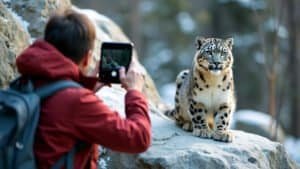Introduction
Eco-tourism plays a crucial role in the conservation of snow leopards, an elusive and endangered species
This article will explore how eco-tourism not only provides financial support for conservation projects but also raises global awareness and fosters sustainable practices within local communities. We’ll discuss the principles of eco-tourism, its economic impact on communities near snow leopard habitats, and the challenges and opportunities it presents for wildlife conservation
By understanding these aspects, we can appreciate how eco-tourism serves as a vital tool in the fight to preserve snow leopards and their natural environment
What Is Eco-Tourism and How Does It Work?
Eco-tourism is a form of sustainable travel that prioritizes environmental conservation, cultural respect, and economic benefits to local communities
Unlike traditional tourism, which can often lead to environmental degradation and cultural disruption, eco-tourism seeks to minimize its impact while actively contributing to the preservation of natural habitats and wildlife. It operates on the principles of reducing waste, conserving water and energy, supporting local economies, and educating travelers about the importance of protecting the environment
The concept of eco-tourism emerged in the 1980s as a response to the growing awareness of environmental issues and the negative impacts of mass tourism. It has since evolved into a key strategy for both conservation and sustainable development, particularly in regions with vulnerable ecosystems and endangered species like the snow leopard
Eco-tourism typically involves small-scale, low-impact activities that offer tourists unique opportunities to experience nature and wildlife while ensuring that their presence does not harm the environment
Eco-tourism’s connection to wildlife conservation is deeply rooted in its focus on preserving natural habitats and protecting endangered species. In the case of snow leopards, eco-tourism offers a way to fund conservation efforts through visitor fees, donations, and sustainable tourism practices. By drawing attention to the plight of snow leopards, eco-tourism also helps raise awareness and foster a global community of supporters dedicated to their protection
Defining Eco-Tourism
Eco-tourism can be defined as responsible travel to natural areas that conserves the environment, sustains the well-being of local people, and involves interpretation and education
This definition, provided by The International Ecotourism Society (TIES), underscores the importance of balancing the needs of tourists with the need to protect and preserve natural and cultural resources. The idea is not just to visit a place but to do so in a way that contributes positively to its preservation
For snow leopard habitats, eco-tourism might include guided tours through mountainous regions, wildlife photography expeditions, or visits to conservation centers where tourists can learn about ongoing efforts to protect this endangered species
The focus is on creating an experience that is both educational and enriching while ensuring that tourism activities do not disturb the snow leopard’s natural behaviors or habitat
The Principles of Eco-Tourism
Several core principles guide eco-tourism, making it a valuable tool for conservation:
Minimizing Impact: Eco-tourism activities are designed to be low-impact, ensuring that they do not harm the environment or disrupt local wildlife. This might involve limiting the number of visitors, using eco-friendly transportation, and ensuring that waste is properly managed
Building Environmental Awareness: Eco-tourism aims to educate tourists about the importance of conservation and the challenges facing the ecosystems they visit. This education can take many forms, from guided nature walks to informative exhibits at visitor centers
Providing Financial Benefits for Conservation: A portion of the revenue generated by eco-tourism is often directed toward conservation projects. This financial support is critical for funding research, habitat restoration, and anti-poaching efforts
Respecting Local Culture: Eco-tourism promotes cultural sensitivity and respect for the traditions and lifestyles of local communities. It encourages travelers to engage with and support local cultures rather than imposing external values or expectations
Supporting Local Economies: By hiring local guides, staying in locally-owned accommodations, and purchasing local products, eco-tourists help sustain the economies of communities living near conservation areas. This economic support is crucial for building local buy-in for conservation efforts
Eco-Tourism and Wildlife Conservation
Eco-tourism has become an essential component of wildlife conservation strategies worldwide. By creating economic incentives for conservation, eco-tourism encourages local communities to protect wildlife and habitats that might otherwise be destroyed by activities like logging, mining, or unsustainable agriculture
In regions where snow leopards are found, such as Central Asia’s mountain ranges, eco-tourism can provide a viable alternative to these destructive practices
For snow leopards, eco-tourism not only generates funding for conservation projects but also helps reduce human-wildlife conflict. When local communities benefit economically from eco-tourism, they are more likely to support conservation efforts and less likely to engage in retaliatory killings of snow leopards that prey on livestock
Additionally, eco-tourism projects often involve community-based monitoring and anti-poaching patrols, further enhancing the protection of snow leopards
The success of eco-tourism in conserving snow leopards depends on carefully managing tourism activities to ensure they align with conservation goals. This includes setting limits on the number of visitors, ensuring that tourism infrastructure is environmentally friendly, and continuously monitoring the impact of tourism on snow leopard populations and their habitats
How Eco-Tourism Provides Financial Support for Snow Leopard Conservation
Eco-tourism plays a vital role in financing snow leopard conservation efforts, providing much-needed funds for a range of activities that directly protect this elusive species
The revenue generated from eco-tourism, whether through entrance fees, guided tours, or donations, is often channeled into conservation projects that focus on habitat preservation, anti-poaching measures, and research initiatives. This financial support is crucial, especially in remote and economically disadvantaged regions where traditional funding sources for conservation might be limited
Eco-tourism also creates economic incentives for local communities to engage in conservation activities. By making wildlife protection financially beneficial, eco-tourism encourages local populations to value and protect the snow leopard and its habitat
This economic model not only funds conservation directly but also fosters a culture of stewardship among those who live closest to snow leopards, ensuring the long-term sustainability of conservation efforts
Funding Conservation Projects
One of the primary ways eco-tourism supports snow leopard conservation is by directly funding specific projects aimed at protecting these big cats. These projects often include habitat restoration, anti-poaching patrols, and initiatives to reduce human-wildlife conflict
In many snow leopard habitats, the money collected from eco-tourism activities is used to employ local people as rangers or guides, who then monitor snow leopard populations, track their movements, and report any illegal hunting activities
For instance, in areas like the Himalayas, eco-tourism revenue has been instrumental in supporting the Snow Leopard Trust, a leading organization dedicated to snow leopard conservation
The Trust uses funds from eco-tourism to implement community-based conservation programs, such as livestock insurance schemes that compensate herders for losses due to snow leopard predation. This reduces the incentive for herders to retaliate against snow leopards, thereby reducing human-wildlife conflict
Additionally, eco-tourism revenue often supports research and monitoring efforts, which are critical for understanding snow leopard behavior, population dynamics, and threats. This research, in turn, informs conservation strategies, ensuring that they are based on the best available science
Supporting Research and Monitoring
Eco-tourism contributes significantly to research and monitoring efforts, which are essential for the effective conservation of snow leopards
Funds generated through eco-tourism are often allocated to research projects that focus on understanding snow leopard ecology, tracking their movements, and assessing the effectiveness of conservation interventions. This research is critical for developing and refining strategies to protect snow leopards and their habitats
For example, eco-tourism revenues have funded the installation of camera traps and GPS collars in snow leopard habitats. These tools allow conservationists to monitor snow leopard populations more accurately and to gather data on their behavior, range, and interactions with their environment
This information is crucial for identifying key areas for conservation, assessing the impact of human activities on snow leopards, and adapting conservation strategies as needed
Moreover, eco-tourism often supports long-term monitoring programs that provide continuous data on snow leopard populations. This ongoing monitoring is vital for detecting changes in population trends and threats, enabling conservationists to respond quickly and effectively
The involvement of local communities in these monitoring efforts, often as part of eco-tourism activities, further enhances the effectiveness of conservation programs by ensuring that they are rooted in local knowledge and supported by those who live in snow leopard habitats
Economic Benefits to Local Communities
One of the most significant contributions of eco-tourism to snow leopard conservation is the economic benefit it provides to local communities
In many regions where snow leopards are found, the local economy relies heavily on agriculture, livestock, and sometimes unsustainable practices like poaching or logging. Eco-tourism offers an alternative source of income that is directly tied to the conservation of snow leopards and their habitats
By participating in eco-tourism, local communities can earn money through various means, such as guiding tours, providing accommodation, and selling handicrafts
This economic benefit creates a strong incentive for communities to protect snow leopards and their habitats, as the survival of these big cats directly impacts their livelihoods. For example, in the remote regions of Kyrgyzstan, eco-tourism initiatives have empowered local herders to become conservationists, as they now see the value in preserving the snow leopard population for future tourism opportunities
The economic empowerment provided by eco-tourism also helps to reduce poverty in these regions, which in turn decreases the pressure on natural resources and reduces the likelihood of human-wildlife conflict
When local communities benefit economically from conservation, they are more likely to support and actively participate in conservation efforts, leading to more sustainable and effective protection of snow leopards
Furthermore, the revenue generated from eco-tourism can be reinvested into community development projects, such as building schools, improving healthcare, and developing infrastructure
These improvements not only enhance the quality of life for local people but also contribute to the long-term sustainability of eco-tourism and conservation efforts by fostering a positive relationship between local communities and conservation organizations
Raising Awareness About Snow Leopard Conservation Through Eco-Tourism
Eco-tourism not only provides financial support for snow leopard conservation but also plays a pivotal role in raising awareness about the need to protect these endangered animals. By engaging tourists in the conservation narrative, eco-tourism helps to build a global community of advocates who are informed about the challenges facing snow leopards and motivated to contribute to their protection
Awareness efforts through eco-tourism extend beyond the immediate experience of the tourist, influencing broader public perceptions and fostering support for conservation initiatives
Awareness-raising is an essential component of wildlife conservation because it transforms passive observers into active participants in the conservation process. Through educational experiences, global campaigns, and the use of social media, eco-tourism can amplify the message of snow leopard conservation to a wide audience, ensuring that these big cats receive the attention and support they need to survive
Educational Opportunities for Tourists
One of the most direct ways that eco-tourism raises awareness about snow leopard conservation is through educational experiences for tourists
When tourists visit snow leopard habitats, they are often accompanied by knowledgeable local guides who provide in-depth information about the species, its ecology, and the threats it faces. These guided tours offer a unique opportunity for tourists to learn about snow leopards in their natural environment, making the conservation message more tangible and impactful
For example, tourists might learn about the challenges of human-wildlife conflict, the impact of climate change on snow leopard habitats, and the importance of preserving these ecosystems. This first-hand experience often leaves a lasting impression, inspiring tourists to become advocates for snow leopard conservation in their own communities
Educational programs within eco-tourism can also include workshops, seminars, and presentations that delve deeper into conservation issues. These programs are designed to not only inform tourists but also to empower them with the knowledge and tools to take action
For instance, they might be encouraged to support conservation organizations, participate in citizen science projects, or raise awareness about snow leopard conservation through their social networks
Global Awareness Campaigns
Eco-tourism can also serve as a platform for launching global awareness campaigns focused on snow leopard conservation
These campaigns often leverage the experiences of eco-tourists to reach a wider audience, using their stories, photos, and testimonials to highlight the importance of conserving snow leopards. By sharing their experiences through blogs, social media, and other platforms, tourists help to spread the conservation message far beyond the immediate area of the eco-tourism activity
Global campaigns might include efforts like World Snow Leopard Day, which is celebrated annually on October 23rd. Such campaigns aim to bring global attention to the plight of snow leopards, highlighting both the challenges and successes of conservation efforts
Eco-tourism operators often play a crucial role in these campaigns by organizing events, providing content for social media, and encouraging tourists to participate
These campaigns are effective in reaching a global audience because they combine the personal experiences of tourists with the broader narrative of wildlife conservation. By connecting people from around the world to the cause of snow leopard conservation, these campaigns help to build a broad base of support that is essential for sustaining long-term conservation efforts
The Role of Social Media
Social media has become an indispensable tool in the effort to raise awareness about snow leopard conservation, and eco-tourism plays a significant role in this process
Tourists who participate in eco-tourism activities often share their experiences on platforms like Instagram, Facebook, and Twitter, reaching thousands of people who might not otherwise be aware of snow leopard conservation issues. These posts can include photos of snow leopards, stories about conservation efforts, and information about how others can get involved
The use of social media allows the conservation message to go viral, spreading rapidly and reaching diverse audiences. For example, a tourist might post a photo of a snow leopard spotted during a guided tour, along with a caption explaining the importance of conserving these majestic animals
Such posts can generate significant interest and support, as followers share the content, ask questions, and express their concern for snow leopard conservation
Eco-tourism operators also use social media to engage with the public and promote their conservation efforts. By regularly posting updates, success stories, and educational content, they keep the issue of snow leopard conservation in the public eye. This continuous engagement is crucial for maintaining awareness and encouraging ongoing support for conservation initiatives
Moreover, social media campaigns can be targeted to specific audiences, ensuring that the conservation message reaches those who are most likely to take action
For instance, campaigns can be directed at younger audiences who are active on social media and who may be inspired to participate in conservation efforts or visit eco-tourism destinations focused on snow leopard conservation
The Impact of Eco-Tourism on Local Communities Near Snow Leopard Habitats
Eco-tourism has a profound impact on local communities living near snow leopard habitats, offering both economic benefits and opportunities for sustainable development
By involving local populations in eco-tourism activities, these initiatives not only provide an alternative source of income but also promote environmental stewardship and cultural preservation. The success of snow leopard conservation efforts is closely tied to the well-being of these communities, making eco-tourism a critical component of both conservation and community development strategies
The relationship between eco-tourism and local communities is symbiotic. While eco-tourism provides financial resources and job opportunities for local people, the active participation of these communities is essential for the sustainable management of eco-tourism activities and the long-term protection of snow leopard habitats
This section explores how eco-tourism empowers local communities, promotes sustainable practices, and enhances cultural preservation
Economic Empowerment
One of the most significant impacts of eco-tourism on local communities is economic empowerment
In remote regions where snow leopards are found, traditional livelihoods such as agriculture and livestock herding often yield low income, making these communities economically vulnerable. Eco-tourism offers a valuable alternative by creating jobs and generating revenue that can be reinvested into local economies
Jobs created by eco-tourism include positions as guides, rangers, hospitality workers, and craft makers, among others. These opportunities provide stable income sources, reducing the economic pressure on local communities and decreasing the likelihood of engaging in activities that could harm snow leopard populations, such as poaching or unsustainable land use
For example, in Ladakh, India, the Snow Leopard Conservancy’s Himalayan Homestay program has successfully integrated eco-tourism into local households, providing supplementary income and reducing human-wildlife conflict
Moreover, eco-tourism initiatives often reinvest a portion of their profits into community development projects, such as building schools, improving healthcare facilities, and enhancing infrastructure
These improvements not only raise the standard of living for local people but also strengthen their support for conservation efforts, as they directly see the benefits of protecting snow leopards and their habitats
Promoting Sustainable Practices
Eco-tourism plays a vital role in promoting sustainable practices within local communities, ensuring that the natural environment is preserved for future generations
Through eco-tourism, communities learn the importance of sustainable resource management, which is essential for maintaining the health of snow leopard habitats and the broader ecosystem
One way eco-tourism promotes sustainability is by encouraging the adoption of eco-friendly practices in daily life. This can include reducing waste, conserving water and energy, and using sustainable materials in construction and crafts
For instance, eco-tourism lodges in snow leopard regions are often built using traditional methods and materials that have a minimal environmental impact, while also showcasing the cultural heritage of the area
Additionally, eco-tourism projects often involve training and capacity-building programs that equip local people with the skills and knowledge needed to manage natural resources sustainably. These programs can include workshops on sustainable agriculture, wildlife monitoring, and conflict resolution, all of which contribute to the long-term conservation of snow leopard habitats
By promoting sustainable practices, eco-tourism helps to ensure that the economic benefits it provides do not come at the expense of the environment. This balance is crucial for maintaining the ecological integrity of snow leopard habitats and for securing the livelihoods of future generations in these regions
Enhancing Cultural Preservation
Cultural preservation is another significant impact of eco-tourism on local communities near snow leopard habitats
Many of these communities have rich cultural traditions that are closely tied to the natural environment, including the snow leopards themselves. Eco-tourism helps to preserve and celebrate these cultural traditions, providing a platform for local people to share their heritage with visitors from around the world
For example, eco-tourism activities often include cultural experiences such as traditional dances, craft-making demonstrations, and storytelling sessions that highlight the cultural significance of snow leopards and the surrounding landscape
These activities not only enhance the tourist experience but also foster a sense of pride and ownership among local people, encouraging them to protect their cultural heritage and the natural environment that sustains it
In some cases, eco-tourism has also contributed to the revival of cultural practices that were in danger of disappearing. By creating a demand for traditional crafts and performances, eco-tourism provides an economic incentive for local communities to preserve and pass on these traditions to future generations
This cultural preservation, in turn, strengthens the connection between local people and the environment, reinforcing the importance of conserving snow leopards and their habitats
Moreover, by involving local communities in the management and operation of eco-tourism projects, these initiatives empower them to take an active role in shaping the future of their cultural and natural heritage. This participatory approach ensures that eco-tourism activities are culturally sensitive and aligned with the values and aspirations of the communities involved
Challenges and Opportunities for Eco-Tourism in Snow Leopard Conservation
Eco-tourism has shown immense potential in contributing to snow leopard conservation, yet it is not without its challenges. While eco-tourism can provide critical funding, raise awareness, and support local communities, it also presents risks that, if not managed carefully, could undermine conservation efforts
Addressing these challenges requires a strategic approach that balances the needs of conservation with the demands of tourism, ensuring that eco-tourism remains a sustainable and effective tool for protecting snow leopards
This section will explore the primary challenges faced by eco-tourism in snow leopard conservation, including human-wildlife conflict, the need for sustainable tourism practices, and the delicate balance between tourism growth and conservation needs
It will also highlight the opportunities that eco-tourism presents for enhancing snow leopard conservation efforts and how these opportunities can be harnessed effectively
Addressing Human-Wildlife Conflict
One of the most significant challenges in snow leopard conservation is human-wildlife conflict, which occurs when snow leopards prey on livestock, leading to economic losses for local communities
This conflict can result in retaliatory killings of snow leopards, further endangering the species. While eco-tourism can help mitigate this conflict by providing alternative income sources and promoting conservation awareness, it also has the potential to exacerbate tensions if not managed properly
Eco-tourism must be carefully designed to ensure that it does not increase the likelihood of human-wildlife encounters that could lead to conflict. For example, eco-tourism activities should avoid disrupting snow leopard habitats, particularly during critical times such as breeding seasons
Additionally, tourism infrastructure should be developed with consideration for wildlife corridors, ensuring that snow leopards can move freely without encountering humans or livestock
To effectively address human-wildlife conflict, eco-tourism initiatives often incorporate community-based conservation strategies, such as livestock insurance schemes or predator-proof corrals, which reduce the economic impact of snow leopard predation. By involving local communities in these initiatives, eco-tourism can help build tolerance and support for snow leopard conservation, reducing the risk of retaliatory killings
Ensuring Sustainable Tourism Practices
Sustainable tourism practices are essential to the success of eco-tourism in snow leopard conservation. Without careful planning and management, eco-tourism can lead to environmental degradation, habitat loss, and increased stress on wildlife
Ensuring that tourism activities are sustainable requires a commitment to minimizing environmental impact, promoting conservation education, and adhering to best practices in tourism management
One of the key aspects of sustainable eco-tourism is limiting the number of visitors to snow leopard habitats. Over-tourism can lead to habitat destruction, pollution, and disturbances that negatively affect snow leopards and other wildlife
To prevent this, eco-tourism operators must implement visitor caps, manage tourist flows, and develop infrastructure that is environmentally friendly and integrated with the natural landscape
Another important consideration is the training and certification of local guides and tourism operators. Well-trained guides can help ensure that tourists follow responsible wildlife viewing practices, such as maintaining a safe distance from snow leopards and avoiding behaviors that could disturb the animals
Certification programs for eco-tourism operators can also promote adherence to sustainability standards, ensuring that eco-tourism contributes positively to conservation efforts
Sustainable tourism practices also involve educating tourists about the importance of conservation and the challenges facing snow leopards. By raising awareness and encouraging responsible behavior, eco-tourism can foster a sense of stewardship among tourists, helping to protect snow leopard habitats and support long-term conservation goals
Balancing Tourism Growth with Conservation Needs
The growth of eco-tourism presents both opportunities and challenges for snow leopard conservation. On one hand, increasing tourist interest in snow leopard habitats can generate more revenue for conservation and bring greater attention to the species
On the other hand, unchecked tourism growth can strain local ecosystems, disrupt wildlife, and lead to conflicts between conservation and development objectives
To balance tourism growth with conservation needs, eco-tourism must be guided by comprehensive planning and regulation
This includes developing tourism policies that prioritize conservation, setting limits on development in sensitive areas, and ensuring that tourism activities are compatible with the long-term goals of snow leopard conservation. It is also important to engage local communities in the planning process, ensuring that their needs and perspectives are taken into account
One of the opportunities presented by eco-tourism growth is the potential for diversifying tourism offerings. Instead of focusing solely on snow leopard sightings, eco-tourism operators can develop a broader range of activities that highlight the cultural and ecological richness of the region
This could include cultural tours, birdwatching, trekking, and educational programs that provide a holistic experience for tourists while reducing pressure on snow leopard populations
Another opportunity is the potential for eco-tourism to drive innovation in conservation practices. As demand for eco-tourism grows, there is an increasing need for new technologies and approaches that can enhance conservation outcomes
This could include the use of drones for wildlife monitoring, the development of eco-friendly tourism infrastructure, or the integration of community-based conservation models that empower local people to take an active role in protecting snow leopards
Conclusion
Eco-tourism plays a pivotal role in snow leopard conservation by providing financial support, raising global awareness, and benefiting local communities. It offers an economic alternative that incentivizes the protection of these endangered big cats and their habitats
Despite its challenges, including the need for sustainable practices and managing human-wildlife conflict, eco-tourism presents significant opportunities for enhancing conservation efforts. By promoting responsible tourism and engaging local communities, eco-tourism can ensure the long-term survival of snow leopards, allowing these majestic creatures to thrive in their natural environments for generations to come










